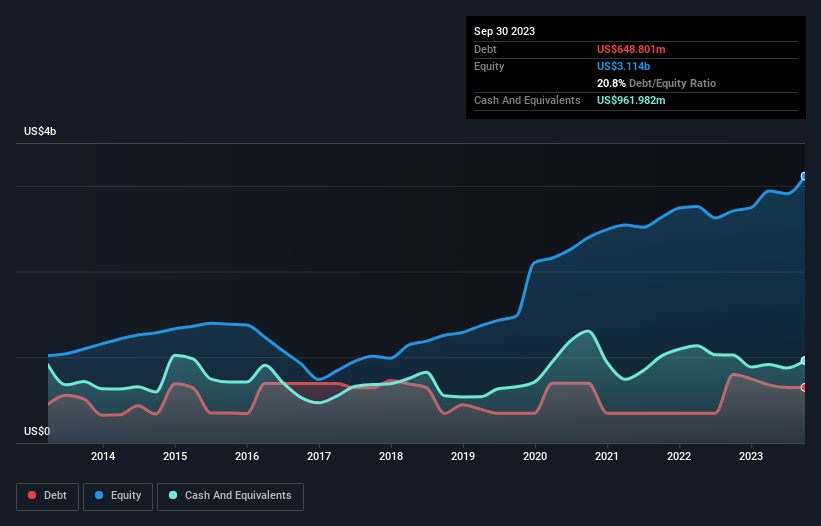- United States
- /
- Software
- /
- NasdaqGS:CDNS
These 4 Measures Indicate That Cadence Design Systems (NASDAQ:CDNS) Is Using Debt Safely

David Iben put it well when he said, 'Volatility is not a risk we care about. What we care about is avoiding the permanent loss of capital.' When we think about how risky a company is, we always like to look at its use of debt, since debt overload can lead to ruin. Importantly, Cadence Design Systems, Inc. (NASDAQ:CDNS) does carry debt. But the more important question is: how much risk is that debt creating?
When Is Debt A Problem?
Generally speaking, debt only becomes a real problem when a company can't easily pay it off, either by raising capital or with its own cash flow. Ultimately, if the company can't fulfill its legal obligations to repay debt, shareholders could walk away with nothing. However, a more frequent (but still costly) occurrence is where a company must issue shares at bargain-basement prices, permanently diluting shareholders, just to shore up its balance sheet. Of course, the upside of debt is that it often represents cheap capital, especially when it replaces dilution in a company with the ability to reinvest at high rates of return. When we examine debt levels, we first consider both cash and debt levels, together.
View our latest analysis for Cadence Design Systems
What Is Cadence Design Systems's Debt?
You can click the graphic below for the historical numbers, but it shows that Cadence Design Systems had US$648.8m of debt in September 2023, down from US$797.8m, one year before. However, it does have US$962.0m in cash offsetting this, leading to net cash of US$313.2m.

How Healthy Is Cadence Design Systems' Balance Sheet?
According to the last reported balance sheet, Cadence Design Systems had liabilities of US$1.26b due within 12 months, and liabilities of US$1.05b due beyond 12 months. On the other hand, it had cash of US$962.0m and US$440.9m worth of receivables due within a year. So its liabilities total US$914.6m more than the combination of its cash and short-term receivables.
Having regard to Cadence Design Systems' size, it seems that its liquid assets are well balanced with its total liabilities. So it's very unlikely that the US$75.9b company is short on cash, but still worth keeping an eye on the balance sheet. Despite its noteworthy liabilities, Cadence Design Systems boasts net cash, so it's fair to say it does not have a heavy debt load!
Fortunately, Cadence Design Systems grew its EBIT by 7.4% in the last year, making that debt load look even more manageable. There's no doubt that we learn most about debt from the balance sheet. But ultimately the future profitability of the business will decide if Cadence Design Systems can strengthen its balance sheet over time. So if you're focused on the future you can check out this free report showing analyst profit forecasts.
But our final consideration is also important, because a company cannot pay debt with paper profits; it needs cold hard cash. Cadence Design Systems may have net cash on the balance sheet, but it is still interesting to look at how well the business converts its earnings before interest and tax (EBIT) to free cash flow, because that will influence both its need for, and its capacity to manage debt. Over the last three years, Cadence Design Systems actually produced more free cash flow than EBIT. That sort of strong cash conversion gets us as excited as the crowd when the beat drops at a Daft Punk concert.
Summing Up
While it is always sensible to look at a company's total liabilities, it is very reassuring that Cadence Design Systems has US$313.2m in net cash. The cherry on top was that in converted 109% of that EBIT to free cash flow, bringing in US$1.2b. So we don't think Cadence Design Systems's use of debt is risky. We'd be very excited to see if Cadence Design Systems insiders have been snapping up shares. If you are too, then click on this link right now to take a (free) peek at our list of reported insider transactions.
Of course, if you're the type of investor who prefers buying stocks without the burden of debt, then don't hesitate to discover our exclusive list of net cash growth stocks, today.
New: AI Stock Screener & Alerts
Our new AI Stock Screener scans the market every day to uncover opportunities.
• Dividend Powerhouses (3%+ Yield)
• Undervalued Small Caps with Insider Buying
• High growth Tech and AI Companies
Or build your own from over 50 metrics.
Have feedback on this article? Concerned about the content? Get in touch with us directly. Alternatively, email editorial-team (at) simplywallst.com.
This article by Simply Wall St is general in nature. We provide commentary based on historical data and analyst forecasts only using an unbiased methodology and our articles are not intended to be financial advice. It does not constitute a recommendation to buy or sell any stock, and does not take account of your objectives, or your financial situation. We aim to bring you long-term focused analysis driven by fundamental data. Note that our analysis may not factor in the latest price-sensitive company announcements or qualitative material. Simply Wall St has no position in any stocks mentioned.
About NasdaqGS:CDNS
Cadence Design Systems
Provides software, hardware, services, and reusable integrated circuit (IC) design blocks worldwide.
Excellent balance sheet with proven track record.

